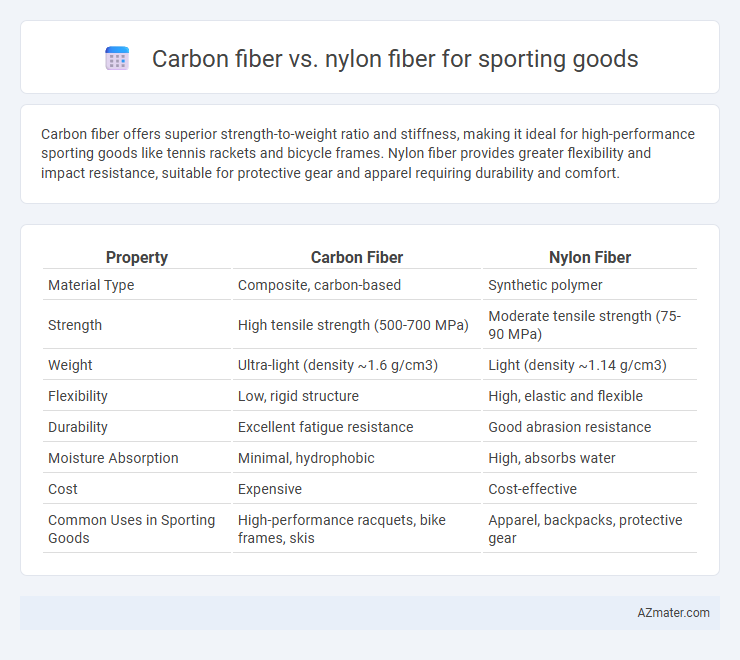Carbon fiber offers superior strength-to-weight ratio and stiffness, making it ideal for high-performance sporting goods like tennis rackets and bicycle frames. Nylon fiber provides greater flexibility and impact resistance, suitable for protective gear and apparel requiring durability and comfort.
Table of Comparison
| Property | Carbon Fiber | Nylon Fiber |
|---|---|---|
| Material Type | Composite, carbon-based | Synthetic polymer |
| Strength | High tensile strength (500-700 MPa) | Moderate tensile strength (75-90 MPa) |
| Weight | Ultra-light (density ~1.6 g/cm3) | Light (density ~1.14 g/cm3) |
| Flexibility | Low, rigid structure | High, elastic and flexible |
| Durability | Excellent fatigue resistance | Good abrasion resistance |
| Moisture Absorption | Minimal, hydrophobic | High, absorbs water |
| Cost | Expensive | Cost-effective |
| Common Uses in Sporting Goods | High-performance racquets, bike frames, skis | Apparel, backpacks, protective gear |
Introduction to Carbon Fiber and Nylon Fiber in Sporting Goods
Carbon fiber and nylon fiber are widely used materials in sporting goods due to their unique properties. Carbon fiber offers high strength-to-weight ratio and exceptional stiffness, making it ideal for equipment like tennis rackets, bicycles, and golf clubs. Nylon fiber provides excellent flexibility, durability, and resistance to abrasion, commonly utilized in sportswear, protective gear, and lightweight equipment.
Composition and Manufacturing Processes
Carbon fiber sports goods consist primarily of carbon atoms bonded in a crystalline structure, produced through the pyrolysis of polyacrylonitrile (PAN) or pitch fibers at temperatures exceeding 1000degC to achieve high tensile strength and stiffness. Nylon fiber, a synthetic polymer composed of polyamide chains derived from petrochemical processes, undergoes melt spinning and drawing techniques to enhance elasticity and impact resistance. Manufacturing carbon fiber involves energy-intensive stabilization and carbonization stages, while nylon fiber production emphasizes extrusion and polymerization efficiency, influencing their mechanical properties and suitability for different sporting applications.
Weight and Strength Comparison
Carbon fiber exhibits a superior strength-to-weight ratio compared to nylon fiber, making it a preferred choice for high-performance sporting goods such as tennis rackets and bicycle frames. While carbon fiber offers exceptional tensile strength and rigidity at a significantly lower weight, nylon fiber provides more flexibility and impact resistance but with increased mass. This weight and strength advantage allows athletes to achieve enhanced control and durability in their equipment while minimizing fatigue during prolonged use.
Flexibility and Impact Resistance
Carbon fiber offers superior impact resistance and high tensile strength, making it ideal for sporting goods requiring durability and stiff performance. Nylon fiber provides excellent flexibility and shock absorption, ensuring comfort and resilience in sports equipment that demands bending and repeated stress. Choosing between carbon fiber and nylon fiber depends on the balance needed between rigidity and flexibility for specific athletic applications.
Durability and Longevity in Sports Equipment
Carbon fiber offers superior durability and longevity in sporting goods due to its high tensile strength and resistance to fatigue, making it ideal for equipment subjected to intense impacts and repetitive stress. Nylon fiber provides flexibility and moderate durability, but it tends to wear down faster under heavy use and exposure to environmental factors like UV rays and moisture. Sports equipment made with carbon fiber consistently outperforms nylon in maintaining structural integrity over time, ensuring enhanced performance and reduced replacement frequency.
Performance in Different Sporting Applications
Carbon fiber offers superior stiffness-to-weight ratio and high tensile strength, making it ideal for high-performance sports like cycling, tennis rackets, and golf clubs where precision and power transfer are critical. Nylon fiber provides excellent flexibility, impact resistance, and abrasion durability, making it suitable for applications such as protective gear, backpacks, and footwear where comfort and resilience are prioritized. Performance differences hinge on sport-specific demands: carbon fiber excels in lightweight structural support, whereas nylon fiber delivers durability and shock absorption.
Weather and Environmental Resistance
Carbon fiber offers superior weather resistance in sporting goods due to its low moisture absorption and high resistance to UV radiation and temperature fluctuations, ensuring durability in harsh outdoor conditions. Nylon fiber, while flexible and impact-resistant, tends to absorb moisture and degrade faster when exposed to prolonged UV light and extreme weather, leading to reduced lifespan. Choosing carbon fiber enhances performance and longevity in environments with high humidity, temperature variability, and intense sunlight exposure.
Cost Analysis and Affordability
Carbon fiber offers superior strength-to-weight ratio for sporting goods but comes at a significantly higher price compared to nylon fiber, which is more affordable and widely used in budget-conscious applications. The cost of carbon fiber materials and manufacturing processes can be up to five times greater than nylon, impacting overall product pricing and accessibility. Nylon fiber provides adequate durability and flexibility at a lower cost, making it a preferred choice for entry-level and mid-range sporting equipment.
Sustainability and Environmental Impact
Carbon fiber offers high strength-to-weight ratio and durability, but its production involves energy-intensive processes and challenges in recycling, raising concerns about long-term environmental impact. Nylon fiber, while less strong, is more widely recyclable and can be partially bio-based, contributing to improved sustainability in sporting goods manufacturing. Choosing between carbon fiber and nylon depends on balancing performance needs with environmental goals, emphasizing the importance of innovations in recycling technologies and bio-based materials.
Choosing the Right Fiber for Your Sporting Needs
Carbon fiber offers superior strength-to-weight ratio, making it ideal for high-performance sporting goods requiring durability and lightweight construction, such as tennis rackets and bicycle frames. Nylon fiber provides excellent flexibility, impact resistance, and cost-effectiveness, preferred for protective gear and apparel where comfort and durability are essential. Selecting the right fiber depends on prioritizing structural strength and weight savings with carbon fiber or opting for affordability and resilience with nylon fiber based on specific sporting demands.

Infographic: Carbon fiber vs Nylon fiber for Sporting good
 azmater.com
azmater.com